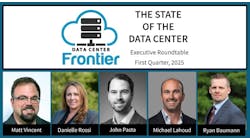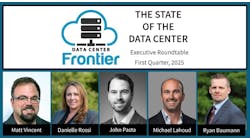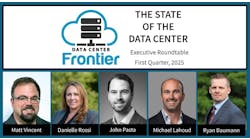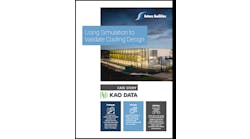Executive Roundtable: Envisioning Cloud, AI and ML Demands for Data Centers' Next 20-Year Cycle
At Data Center Frontier, we always like to ask the experts -- in this case, the four seasoned data center industry leaders featured in our Executive Roundtable for the Fourth Quarter of 2023.
We begin today by asking our experts' opinions on escalating AI, ML and traditional cloud requirements, as the data center industry hurtles into a widely forecasted “new twenty-year cycle" of growth. What will be the most key factors for enabling the industry’s ability to meet such demand next year and beyond?
In addition to today's discussion, in forthcoming days our panel of executive thought leaders will offer their observations on other pertinent industry topics, including:
- Considerations for "adaptive reuse" of vacant office, retail and other commercial real estate properties for data center design and construction development, which remains a gathering trend in North America, especially in urban markets facing slim availability of critical land and power stakes.
- Takes on which data center onsite power generation technologies and solutions present the best outlook for investors, developers and providers seeking to balance short- and long-term ROI considerations with the industry’s clear and present drive toward sustainability.
- Opinions on main chances going into 2024, geographical and otherwise, for an expansion of U.S. manufacturing capabilities for providers of equipment to the North American data center industry looking to bring supply chains for critical infrastructure closer to their customers.
Here's an introduction to our distinguished panel:
- Zech Connell, VP, Program Development, BluePrint Supply Chain
- Nicole Dierksheide, Director - Category Large Engines>600KW, Kohler Co.
- Drew Thompson, Associate VP, Commercial, Connectivity and Industrial Group, Black & Veatch
- Mike Zapata, Head of Data Centers, Siemens Smart Infrastructure USA
Over the course of this week, we’ll moderate a Q&A with these executives on each one of the three roundtable topics.
We begin today with our Executive Roundtable's remarks on escalating AI, ML and traditional cloud requirements as the data center industry hurtles from the inflection point year of 2023 into a widely forecasted “new twenty-year cycle" of growth.
Data Center Frontier: After this landmark year of unprecedented anticipation for artificial intelligence and machine learning (AI/ML) technologies amid escalating requirements in the traditional cloud, the data center sector is poised to experience even greater urgency of demand. As we proceed into a widely forecasted “new twenty-year cycle" of growth, what will be the most key factors for enabling the industry’s ability to meet such demand next year and beyond? What persistent challenges stand most to inhibit this ability?
Zech Connell, BluePrint Supply Chain: Growth will continue to accelerate, with manufacturing and construction speeds remaining the primary rate-controlling factors.
Given that we are an organization that specializes in industrial supply chain management, we have a unique perspective on the factors that have the greatest impact on project timelines.
The industry requires more gear to be produced at a faster rate with a more efficient supply chain infrastructure.
The industry needs more unique NA manufacturing and integrating partners, bringing Tier one and Tier two products closer to construction site demand.
Providers also need strategic supply chain partners to help establish these unique relationships and ultimately deliver gear from manufacturers to construction sites in a more efficient and controlled manner, executing on all touchpoints, from vendor management, visibility, storage, delivery, and setting.
The increase in demand has exceeded the capacity of traditional infrastructure deployment methods to efficiently support it, and this will continue to challenge project timelines and milestones well into 2024 and beyond.
Nicole Dierksheide, Kohler: A landmark year indeed! When it comes to the anticipation of AI and all that it brings, Kohler is not alone in evaluating current capabilities and future enhancements to better serve our global customer base.
Of course, we will be keeping a close eye on the inevitable power uptick that the development and implementation that AI technologies will create in the areas of data management, processing and accessibility and how it will impact our industry.
We have read reports that AI applications will consume more than 3X the power than traditional enterprise applications and the role that back up power will play to support these increases will be critical to minimizing downtime and interruptions.
Of course, challenges will be part of the growth process. Adequate security will continue to be a persistent challenge as AI becomes more and more integrated.
In addition, compatibility between newer and older technologies is a potential area of concern.
Drew Thompson, Black & Veatch: Today, technological advancements and unforeseen developments like AI/ML have become much more than influencing factors; these advances are rewriting the specs of the industry. As a result, AI has had a significant impact on the trajectory for data centers, their development and their operations.
For example:
• AI’s computational requirements and processing needs have moved the average 20-100 MW of power consumed by a new data center to what is becoming a more common 500 MW data center.
• This spec has shifted demand for an enterprise data center to a new standard HPC (High Performance Computing) data center and changed the development protocols for location, powering the sites, and building access within communities.
• The need for specialized hardware has taken us from CPUs to GPUs and TCUs high density racks running at +/- 200kw per rack . While this is changing the schematics for both the data center and it’s infrastructure on campus, utilities are struggling to meet demand within their chartered purpose. Privatization of the grid is one area we see growing quickly.
• Liquid cooling solutions and other technologies to manage heat generated by the chips/racks is rapidly evolving and changing the infrastructure needed to support these data centers.
• Managing associated heat and power requirements is a crucial consideration
• The most prohibitive challenges facing data center owners and operators today are quite possibly Regulatory Compliance and Security. Cybersecurity, physical security, industry specific regulations, all offer protection to highly sensitive data and insights. Regulatory Compliance makes it feasible to build an equitable platform for data use and computation that serves the many, not just the few.
Meeting these demands raises creative challenges for the best minds in the business. AHJs [agencies having jurisdiction] are struggling to support public policies that expand and protect businesses they serve.
New designs and sites that respond to community and market, with the ability to manufacture the equipment needed, the willingness to be responsive to Scopes 1, 2, and 3 in a sustainable environment, and the ability to do more with less, are nuanced factors influencing data center development across the globe.
There is little doubt ingenuity and discovery will prevail in the challenges posed by new technology.
Mike Zapata, Siemens Smart Infrastructure USA: It’s a fascinating time to be in this industry and all the feedback from our clients points to the demand cycle you mention.
This, coupled with other adjacent industry challenges of demand brought on by the Semiconductor, Battery, Industry 4.0 (and 5.0 just ahead), and power grid markets, contribute to this “new twenty-year cycle” of growth.
Some of the key factors for enabling the industry’s ability to meet such demand next year and beyond are predictability in lead times and supply chain, standardization, and leveraging AI/ML to help optimize and improve energy efficiency while reducing carbon footprints.
All of this, coupled with solid customer relationships, will allow us to do good forecasting to help meet our customers’ expectations.
With unprecedented growth also comes the persistent challenges that can impede that growth. Today, we’re already seeing some regulatory challenges with constrained resources (power and water). This will become increasingly important as the infrastructure needs to scale and expand into secondary markets.
Additionally, as technology evolves, the need for skilled labor is already a major factor and industry, educational institutions, and trade schools will need to align more aggressively to meet the skillsets of tomorrow.
Next: Tips On Adaptive Reuse of Vacant Properties for Data Center Design and Development

Matt Vincent
A B2B technology journalist and editor with more than two decades of experience, Matt Vincent is Editor in Chief of Data Center Frontier.









